uju
Bird Song
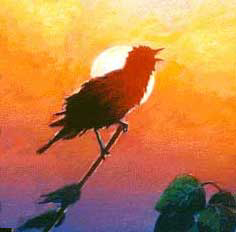
Bird Sounds and Knowledge
(a meditation on birds in 10 poems)
The Fragile Song of Learning
The Sound of Existence
A Life Worth Living
Ode to Bird Sounds
Songs of the Feathered Rainbows
Songs of Extinction
Attar's Errors
Empathetic Ornithology
Flying Over Fences
Long Live the Fragile
The Fragile Song of Learning
I don't know much about birds.
No, that is inaccurate.
I know only a little about bird song.
Not quite.
Birds have taught me a little about themselves---
or rather:
birds taught me they have selves;
close, but try again:
I know a little about the selves of birds
because they honored me by teaching me.
I learned they were beings with selves
and they honored me
with a minimal understanding
because I love and respect them.
Yes. That is the way it was and is.
I loved birds from an early age
but
I began to study birds in earnest
after I nearly died and
realized that I had to unlearn
most of what I had been taught
and what I thought I knew.
I don’t know why returning
from the Nothing that is death
should have made me love these
feathered beings so.
Maybe it was the sun that shone on their feathers
or their love of life and flight
like flower petals drifting down
in the morning light
luminous wings fluttering
against gravity
in the golden shade.
Maybe it was their shy eyes
like fragile lamps, lighting up
a different way to see for me.
But I am grateful birds have undone
my conceit and certainty
as well as question my ignorance
and left me standing still in the open
naked of pretence,
vulnerable and alone
straining to hear and see
for the first time.
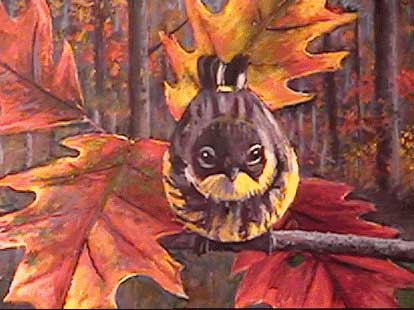
Yellow Rump Warbler and Oak Leaves
The Sound of Existence
Listening to the Curlew cry--
like the sound of the earth
asking the question why--
why the pain of being:
why the partings and returnings,
and why the joy of seeing?
What is a bird's life?:
the whistley rounds of wrens
warble a bubbling tent of protection
around their babies in the gourd-nest in our back yard.
I've hard
long distance crows caw to crows,
and
seagull cry to each other at sea....
what do they all mean?
Listening to the chickadee’s spring song
sounding like "Me Free?" or "Free Me?"
like the fragile sound of existence
that does, and does not, want freedom.
I know these sounds like I know sunsets.
It took almost dying for me to learn
to hear sparrows singing with new ears
out of my window.
Birds do not voice the sound of "heaven",
as the poets say,
nor the sound of Bach Chorales or Gregorian chants,
not even the 3-toned Humming Oms of Tibetan monks.
Listening to my heartbeat
I realize that in bird song is the song of life,
singing to itself,
imperfect, mortal melodies---
scientific sonograms evoking genetic memories,
songs about family and nesting.
Cedar Waxwing gather among bushes of red berries---
and sound like blue fire and yellow wind
and the sun of being in their courtship---
as night comes-- singing glass songs into
the into a sky void of human made gods and fictions---
and the whole meaning of life in the sound
of birds at sunrise
Rising above the stillness of the earth's silent turning ,
bird sounds hover clear and fragile
as when a child first opens its ears
to the voice and heart beat of its mother.
Eggs sit woven into a nest of mind
beneath the mother bird-breast
warm as sunshine.
I am not better than a baby bird
just come out of the nest,
overwhelmed by a world
too big for my mind to grasp.
BIG WORLD, is what the baby bird first sees.
Amazing wonders in the midst of all the suffering.
I was once too young to know suffering too.
I begin to understand why
birds clutch to twigs
when first out of the nest
and why they run and hide behind leaves
and why. too,
when the sun appears
they begin to carol in joy.
One must be careful where and how one sings
but even on cloudy days,
what bright-winged sound gives birth
to the suppressed promise of each day!!!
Bird song is the song of living
The song of not wanting to die
A song of love for the fragile fragrances of the
hard struggle to live on earth.
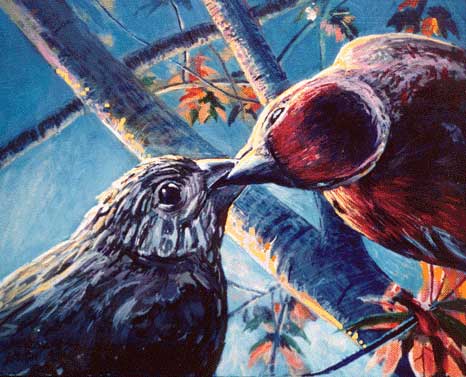
House Finch and Baby
A Life Worth Living
(Flickers)
Two Flickers dance on a branch
heads down, in a motion partly
darning like a needle,
a deep bowing of respect,
beaks pair and thrust
like the movement of love,
wind swaying in branches,
a living rite older than human rituals,
and then they fly, both of them
one chasing the other
under the canopy of spring trees
calling, yellow wings from underneath
like feathered sunshine,
like palm leaves at twilight
glowing within, ---fans cloaked in morning light---
light, wings, light, wings
yellow sunlight, glowing,
in clear flight
of bright wings and
their sound piercing the air
with the longing cry
of the forest at dawn.
Birds sound is the meaning
of a life worth living.
The earth is a rounding dawn
of birds singing morning into being.
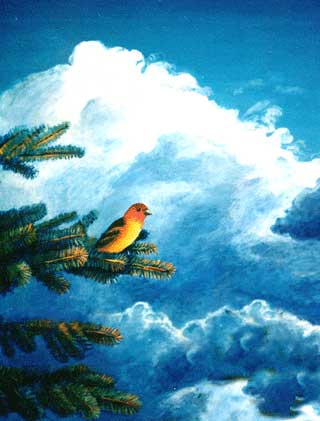
Western Tanager
Ode to Bird Sounds
The earth is a rounding dawn
of birds singing morning into being.
And the songs, insistent,
persistent, hungry with life
full with desire, longing for each other
not just sterile "contact calls"
as ornithologists name them
but familial duets, family chants,
endless conversations,
the caroling of care between mates
wedded to a nesting site---
Crow to Crow, talking, telling the tale of the hour
calling all Crows to roost at twilight
calling the young ones to rest.
Chickadees at the nest coo and question---
little cries calling to their babies.
These are the sounds intelligence makes:
the heart of the forest and the mind of the hills
talking a secret avian tongue.
Every bird is individual, not species--
species is an abstract generalized fact,
viewable only form a distance
The individual Great Crested Flycatcher that sings
his morning and evening song behind my house
reminds me how precious
my mornings and evenings are too.
I have heard the mating voice of Sandhill Cranes
coming over a far ridge,
or the voice of Tundra Swans or Geese
coming in from over the sea.
Male Pileated Woodpecker to female Pileated Woodpecker
calls over the Wetland,
telling the tale of where the berries are
and how the nest is, high in the Sycamore
and when the predators came
and now they are gone.
Every bird is local and sings in a time
and every time is a space
and the space of the world is a specific place
that carries the ancient commentaries
of the voices of birds.
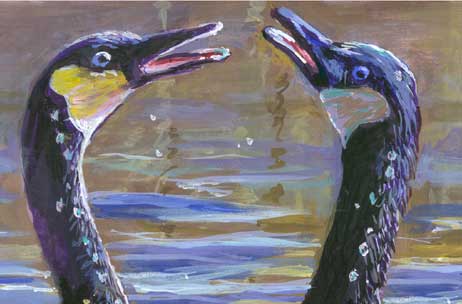
Duet
Bird sounds, in aboriginal, wordless eloquence
ask the ancient questions
and assert the ancient answers---
"I am because I am", they say
"where are you now?"
"where are we?".
"where are we going?
"Come, here is some food"
"I am happy"
"I am afraid"
"There is something to be afraid of"
"I am me"
"Do you love me?"
"Will you take me"
"Do you love my feathers"
"Is what I say beautiful?
"Am I beautiful or handsome?"
"This is our family"
" We are related
this is our world, our trees, our desert
the world is wonderful:
existence is amazing".
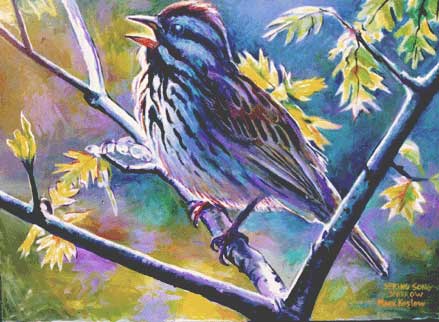
Spring Song Sparrow
Some people have told me no one can really know animals
and that birds are essentially foreign to humans.
This is not true.
People choose to not to spend the time
it takes to listen to birds
The little I know that birds have taught me
tells me that they better and smarter than many humans.
I've grown familiar with chickadee intimacies
and sprightly Tufted Titmice
young ones playing in the trees.
I have sat beside hummingbirds for hours, weeks, months
and shared starlight with owls.
I have walked alone along an endless beach
sharing an elemental infinity with shorebirds,
godwits chatting and quavering in the twilight estuary.
I've looked into the cormorants Caribbean-blue eye.
I have looked in the eyes of Crows
and seen brilliant minds there.
Orioles have taught me that real meaning of gold
is morning sunlight
and goldfinches about how to be a parent.
I have learned from Barn Swallows and many other birds
that the price of being poor and small is well paid
on an earth where the rich impoverish the world.
Money and power cause atrocities.
Only smallness matters: proximity: constancy:
the intimate rainbows between fragile beings,
individual eyes and hearts, close as eyelashes,
looking and feeling across kinds and species,
a personal knowledge born of hands and wings,
paws and whiskers,
where those who know
understand that to "know" is to care.
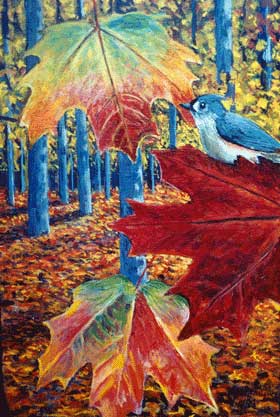
Tufted Titmouse and Maples
Blue Jays have stolen my heart
and I love them even when they stole my peanuts
or ate my breakfast
and even after they deceived me
into thinking they were Blue Tailed Hawks .
The catbird can play more variations
on a few notes than Louis Armstrong
could play on a trumpet
The first time I heard the Hermit Thrush
and did not know what it was,
I called it the glass-flute bird
its voice like a cascade of starlights
down a waterfall of twilight.
Better than Mozart,
whose morning cheer I love
but this thrush’s song is clearer
and expresses an ancient memory
of an even more ancient
longing for love and beauty.
Sad twilight falling into
the rising of the stars,
intimations of the magic of morning
about to arrive.
Song is all context
a relation of small, intelligent beings
to a wider world
that they know and thrive in---
it is a language of intimacies and protections,
and only being intimate with birds
teaches its meaning.
The language of the birds
is not a mystical conceit---
a secret language only an initiated
Sufi or Native American can understand-- no--
the language of the birds is the common language
of a tribe of individuals---
a web of sounds that holds them
in far flown embrace and gentle concert,
holding them together against the threats of the world.
Bird songs precede human music
just as bird dances predate,
and are the unacknowledged foundation
of human dance and ritual.
Ballet is clumsy compared to the sky-dance
of Pelicans, or Hummingbird's winged
iridescence, cool- jeweled flames
dancing transparently
between flower petals.
Humans mistake their own inability to translate
the language and culture of birds
for the inarticulate shallowness of bird sound.
A overlooked truth is that bird sounds
are not about humans, they are about birds.
The meaning of the assumed lack of depth of bird sound
is the refusal of humans to really listen and watch.
Birds are not responsible for the human refusal to know them.
The only Rosetta Stone for the language of birds
is the love and time one spends listening to them.
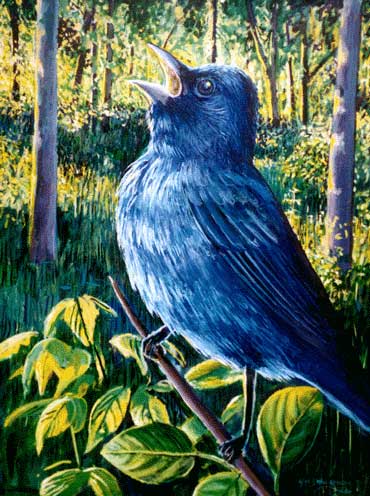
The Sky Singer
(Indigo Bunting)
Many humans express the
self important opinion that
their language is superior and while non-humans 'communicate'
but have no language..
Indeed, human vanity claims only ‘we’ have language
when language is narrowly defined, and this may be true.
But I doubt that birds agree.
I have asked birds
what our language means to them.
I have heard birds talk about me in the woods.
Mostly they complain about humans,
and ignore the silly, meaningless symbols that issue
from our mouths.
They have asked me not to harm their babies.
They see us, rightly,
as clumsy, big, dangerous predators--
unless, with great patience,
one tries to earn their trust.
Birds do not kill each other
about disagreements
over the same word in different languages
as humans do.
Human animals suffer and cause others to suffer
from the alien babble of disconnected words.
The genetic syntax of a universal grammar
has not prevented World Wars.
"Words, words, words"---
words
have lies in them because
they do not have hands,
they do not stroke my cheek
feel raindrops, sprout buds
have feathers or absorb sunlight
deep under the green leafy skin---
language is not the
luminous blood of wordless lives.
The poetry of bird song is suggested
in sonogramic hieroglyphs.
Bird songs dance in complexities
more ornate and lovely than a Bach score.
Birds have a language
not made of clumsy, abstract words---
distant symbols and artifacts
of a divorce from nature---
but of musical elements—elemental sighs, cries,
whines, shrieks, lyrical endearments and
patterned melodies,
infinitely subtle modulations
all closer to reality than human language.
Theirs are fragments of the sounds
of wind weeping and the moaning sea,
abalone dawns and wildflower desires;
reverbing waterfalls down stone cliffs
Dippers diving in the froth;
vast mountain snows dripping,
falling walnuts on hollow logs;
endless sheets of arctic ice,
muffled by the humm of huddled Emperor Penguins;
sky blue screeches muffled by jungle blossoms;
river rushings, tree creakings,
leaves rippling and scratching rough stones,
humus and humms
of warbled mists and cicada drones….
In the thin elegance
of small avian voices
I hear the high glass notes of prehistory---
ancient cries of longing,
the fragile warbles of feeling ---
the living heart of existence,
clear sea-blue whistles,
and deeper---
ocean haunted wails,
albatross echoed lands of sunset,
tribes of red-eyed Night Herons
camped a redwood tree
squawking under the sea-drunk moon:
croaking lines of Brown Pelicans
following the elegant and breaking
scroll of curling waves;
the harsh notes of Terns and gulls
reverberating huge distances
from the Arctic to the Antarctic
along the oceanic paths of Blue Whales---
and much closer
the delicate importuning of 2 Winter Wrens
softer and sweeter than morning lovers.
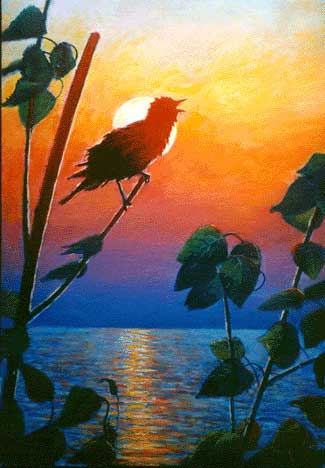
Redwing Blackbird at Dawn near Lake Erie
I hear the chirps and peeps of baby birds crying,
delicate questions at dawn
intimate requests and contentments,
family chatter, spousal insistences,
screams of help and outrage and deep sighing,
piercing alarms of pain and hunger----
And I hear birds sing
the song and call of being
singing not an earth song
but the song slightly above the earth
as if the voice of the earth levitated, hovered,
like a silken sound-veil the earth wears
like a web of sound at tree level
weaving a musical space
a harmony in discord that fills the air
with the unsaid, not so secret song
that life sings to celebrate
its own existence.
I listen to the high, red-orchid squeaks
of hummingbirds
under the forest canopy,
or the evening songs of Robins
like twilight variations of Mother-of-Pearl,
and I hear the sounds of what it means to be,
and I am embarrassed by the vain and mind twisting
inadequacy of my human tongue.
Bird Song!!--- It radiates an
exquisite and delicate mystery
far too elemental and rarified,
far too ancient and fragile
for humanity to make much sense of it !
But I try to listen to them,
year after year,
and slowly, gratefully
I hear in their songs
the meaning and sound
and depth of my own love of life.
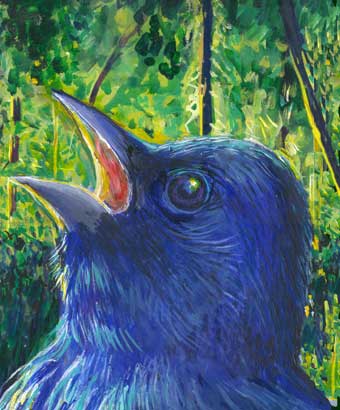
Songs of the Feathered Rainbows
(On the History of the Meaning of Feathers)
The colors of birds, like their songs
express the fragile intimacy of their relation to the world.
The earthy song sparrows are colored ochre and dusky
as the cordgrass and other grasses they nest in.
Red Knots picture red Tundra grass in their bodies.
and Ptarmigans are a changing poem made of feathers--
feathers mottled like ruddy Bunch grass
or designs that blend into snow.
The Meadowlark breast is a yellow sun rising
on the vast prairie covered with wild sunflowers,
The Evening Grosbeak looks like twilight
behind
aurora borealis of Canada.
The Blue Jay wears the sky on its back---
dusky lilac or summer cerulaean---,
and the Yellow Warbler wears
the color of sun saturated trees---
a breathing, brilliant, sunset yellow.
The Wood Duck swam into the rainbow,
and the endangered Scarlet Macaw
is a riotous flowering of color,
lifting the rainbow back into the sky
in the jungles of spring---
feathers blossoming into
blue, green, red and yellow.
The landscapes of all the world are
woven into birds as tapestries of flight
a Wrens wing patterns are like A Turkomen
oriental rug,
not quite liver colored but intricate.
All feathers resemble Indonesian Ikats,
dyed vanes like strands of colored silk,
design
vistas recreated as plumage
distilled into the poetry of bird feathers,
Hoopoe crests and Peacock iridescent eyes, c
Cornocopia of Turkey feather spread out
like a fan of lovely forest art, like Paul Klee fantasies,
full of wit and intelligence, Manikin abstractions,
like surreal Bauhaus fantasias or Birds of Paradise,
rapt and stunning in weird compelling
attention grabbing designs .
The feathered clothes birds wear mirrors the beauty of
place
like water mirrors the sky.
The world’s spectrum of birds
in their plumages
distills rainbows of feathery jewels
so spectacular and diverse that no human raiment
or design will ever rival this marvel of variety
for color, shape, design and form.
If the earth has an artist or a poet
to express its multicolored beauty,
it would not be a god with a compass
or an human artist with a brush ,
but all the birds with their feathers,
painting with their own bodies
the glorious painted poem of desert flowers,
opal jungles, forest sunsets, moon seas,
aquamarine twilights, autumnal harmonies
golden prairies, and arctic passes
over the summits.
Some birds
carry human vanity around
them like a ball and chain, or rather a
neckband or a leg band, trapping them on snags.
Henslow's, Baird's, Bachman's, Brewsters or Botteri's Sparrows
or Harris's Hawk, all badly named after someone's ego.
But other birds, fortunately, have not been saddled with human conceit
and are even more lovely than their names imply,
No human artist could ever have conceived
the beauty of the Quetzal, Oriole or the
Flame Faced or Opal Rumped Tananger:
the Spangled Cotinga,
Sapphire, Peacock Coquette, Ruby Throated
or Streaked Tuftedcheeked Hummingbirds----
the Sun Parrot, Orange Bellied Euphonia, Purple Honeycreeper
or the Sand Colored Nighthawk, all of the Americas.
In Africa there is a rainbow bird called the Purple Crested Turaco
and there is the
Yellow Bellied Sunbird and Redfaced Crimson Wing
In India The Gold Breasted Fluvetta, Fire Breasted Flower Pecker,
Wedgetailed Green Pigeon and the Fire Tailed Sunbird.
In Indonesia the Birds of Paradise wierdly raptured
and dreamtime songs in surreal and hypnotic beauty,
From the European Blue Tit to the Bornean Blue Flycathcer
from Egrets, Pheasants, Eagles, the Finches, Trogans
to the Lyrebirds, Peacocks, Wrens, Redbirds, Warbers and Herons,
the world's birds express the joy of life on earth.
The greatest Art of Birds is the birds themselves;
they are magicians of light, sound, and color in flight.
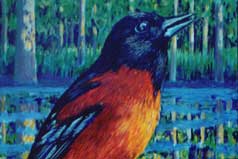
Heron Culture
The Blue Heron spends most of its life in trees
close to the sky and in water
and its body expresses the elements it loves.
They are huge birds, with wings that hold gallons
of ancient
air, liquid blue bodies, long and sleek necks,
--- an eye the yellow of a prehistoric sky---
and their feet are knarled sticks to hold crooked branches.
It voice recalls Archaeopteryx,
the ancient bird of 150 million years ago
the questioning airborn ‘kaaaawllk"
of the primal wetlands. They nest in large colonies, rookeries
---a Heron culture, a Heron Pueblo, a Heron city--
hundreds of strange birds, blue beings,
all standing tall on large stick nests
and the pumping sound of their mating calls
sounds like a "dreamtime" song that is neither
about dreams or time, but rather is real
and negates time, year after year,
sounding the triumph of Heron continuity.
The Male Heron flaps its wings, jumps up
on the back of the female
and stands on it, bird stacked above bird, and they mate.
And the male goes and gets her a stick
which he gives to her as sweetly as a shy flower
and she places it in the nest with grace and delicacy.
The Blue Heron has a culture
equal to the Pueblo, Lakota or Yanomamo
a culture more than equal in its right to be
than Tokyo or Salt Lake City.
Songs of Extinction
But this ability of birds to express the beauties of earth
in their own bodies
excited the envy of humans
and ever willing to betray Nature's Rights
humans stole Egret feathers, Terns, Turkeys, Hummingbirds
Acorn woodpeckers, and a thousand other kinds of feathers
for vain and passing fashions, women’s hats
Hawaiian cloaks for kings
and other pretences thieved from nature.
The Amazonian birds are dying so Brazil
can grow soy Beans for the Chinese.
So one must ask, at last:
Why have humans failed the birds,
these most beautiful beings of a beautiful earth?
What have birds ever done to humans
that humans
have punished and harmed them so?
Birds have done nothing to harm humans
and
the Miner's Canary sounded decades ago
that the earth is in trouble
but who is listening to the birds?
I must admit it---
I studied religions for years
and at last come to the conclusion
that it is too outmoded, archaic, artificial ---
a beautiful and seductive lie, an embellished mirage---
and on many things, false.
What good are dreams of the 'other world'
when this world is neither understood or cared for?
Religion has failed the birds
and nature generally.
Nature has no estates:
there is no ladder or chain of being
leading up to "Enlightenment",
no Karmic Round favoring human birth
over the birth of animals,
no mystic oneness that supersedes the many
beings that live in Madagascar or the Hebrides.
The Tao does not exist -- nor does the "void" exist
nor is Tao and void superior to the "ten thousand things".
The Crane is not the Emperor
and a humanized "creator" did not make "creatures"
or the
the seas and mountains as an advertisement
or symbol of "His" power.
The dove is not the "holy spirit"
pictured as a white bird in the paintings of El Greco
or thousands of other paintings
or part of a theological trinity.
I see nothing holy in a "spirit"
that claims dominion and a right to exterminate other species.
How ‘holy’ is a spirit that symbolizes itself with a Dove
and kills off millions of actual doves.
The Passenger Pigeon was a kind of Dove
forced into extinction by hunters
Pilgrims, Markets and Collectors
all who believed in the "holy spirit".
and claimed a "Christian" right to kill. The Passenger Pigeon was thought by some
to be the finest of all pigeons.
There were perhaps a few billion of these birds
flying in huge flocks and nesting in great colonies
across eastern North America
shot out of the sky by the greed of hunters
and their habitats destroyed.
I have only seen one
a stuffed desiccating skin owned by the Seneca Indians,
Iroquois of New York State, a tribe that loved the bird
and mourns its passing.
It was a beautiful bird, long and elegant and colored with a dusky
twilight, like an abalone shell dawn.
Thoreau loved them and describes their sound as a "quivet"
Similar to the "creaking of trees" (sept. 12, 1854)
But their huge flocks are gone now
and no sound from them will ever be heard again.
Where can I hear the sound of the Eskimo Curlew
muffled by the tundra,
or a live Ivory Billed Woodpecker or Carolina Parakeet
calling through the Pines or Maples ?
And what was the sound of the Dodo
whose peaceable nature was abused by
the "discoverers" and self interested "explorers"
whose real interest was money
and who murdered off the great Moa and the Great Auk,
and silenced the Guadalupe Caracara.
Who, but a few, mourn the New Zealand Quail
or the White Winged Sandpiper?
Who listens to the absence of the Laughing Owls
or the lost Paradise Parrot?
Does anyone care that the sound of the Mamo, the Huia,
the Koa Finch, and the Cuban Red Macaw are silenced?
Extinct, listen to the sound of no sound ever again,
Extinct, through human fault alone,
Extinct
Albatross,
extinct
Rails, Hummingbirds and still more thousands of species
headed for extinction, and hardly a few tears for them,
so long as the greed goes on.
I long for the return of the Spectacled Cormorant
and Pink Headed Duck
but no one will ever hear their voice again
or know if they have arrived.
They will never arrive.
There is nowhere to go, no one to listen
no further existence, nothing left, utter, complete absence
and no way to understand an emptiness this final.
In this emptiness that underlies and real
understanding of bird sounds.
Attar's Errors
The biblical gods and the concept of human supremacy
have not taken care of the sparrows
and helped many species go extinct.
Even in Islam, as in other major religions
atrocities against and birds and nature abound.
The Persian poet Attar (12th century C.E.)
exploiting an ancient indigenous love of birds and animals
of Pre-Islamic Native cultures
re-made birds into Sufis
in his Conference of the Birds
and he killed off nearly a thousand birds
so that the middle eastern Hoopoe
and a mere 30 of the avian elite
reach the mystical bird he calls Simurgh.
And the Simurgh, it turns out
when they look in a mirror
is themselves, these 30 birds,
and they see that they themselves
are the Ultimate Truth after all.
Very clever, narcissistic self exaltation---
but birds are not Sufis or symbols
and Attar’s allegory rings false.
Birds and not metaphors.
Birds do not need transcendent mirrors
or gods to exalt their delusions of magnificence.
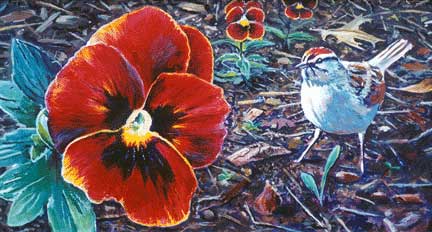
Chipping Sparrow and Pansy
Empathetic Ornithology
Science has not failed the birds as badly as religion.
Not as false as Attar’s fables,
the art of Audubon
who murdered the birds he painted,
is still an art that tries to be accurate.
We inherit Audubon's' moral duplicity.
While it is true that some of bird science is built up on
the bloody wings of birds
tortured in gruesome experiments
vivisection, mixing the brain matter of
pigeons and chickens in a genetic soup,
science has saved the Whooping Crane and the Condor
and will yet save many others from the
depredations of superstition and greed.
Is science to blame for those who abuse it?
Torturing out avian truths from live birds,
scientists cut out the gonads of male birds
to see if they will sing to females
and they murdered all the birds in 40 acres to see
which birds would resettle the area.
Thousands and thousands of such experiments
prove nothing so much as the moral barrenness
of the mind of some scientists.
Disinterested knowledge, "pure" research
is no excuse for
cruelty.
Beware of the fascism of disinterestedness.
Good is a science that feels for what it studies.
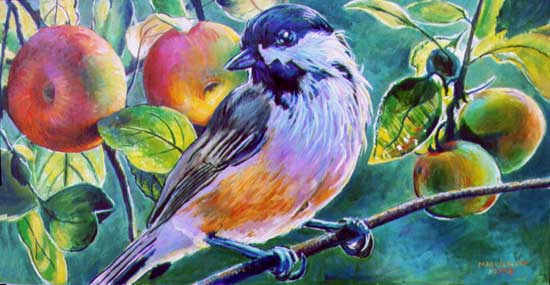
Chickadee and Apples
Birds have been on earth for 150 million years
and humans in their modern form
have only been here 100,000 years
and the scientific study of birds
is little more than 200 years old
and therefore ornithology
is only beginning to claim to "know" birds!!
Making lists of birds or measuring their brain casings
is only to know only aspects of them,
But slowly, we are learning to know
birds form their point of view.
The growth in knowledge of birds
has
been accompanied by the extinction of so many species
that I question the same society that claims to know them?
At what and at whose cost is this knowledge purchased?
What is a "knowledge" that cannot save what it studies?
In the 1930's
Bill Tanner could not save the Ivory Billed Woodpecker,
though he tried. He "knew" the bird
The logging companies caused the extinction of the Ivory Bill.
They were blinded by greed.
I saw the stiff corpse of an Ivory Billed Woodpecker
in the basement of the Cleveland Museum of Natural History
Knowledge of the extinct bird’s corpse
is cherished by a few in museums
and a growing number outside the museums.
But still, birds are declining all over the earth
50 Million of years before Magellan
Birds migrated longer distances than he,
and did not brag about it
or called themselves great heroes
or leave dead Native peoples or decimated ecologies
in their wake, as did the followers of Magellan.
The history of study of birds is partly the
story of an earth bound envy
of avian liberty
cutting the wings of free Flamingoes---
and putting them in cages.
Collecting the rare, museums
put the Birds of Paradise
in a museum box,
endlessly catalogued, cabinet drawers
of avian corpses or "study skins" as they call them.
That is one aspect of Ornithology.
But Ornithology is also the study of what is most loved
and the drawers of dead birds also are cabinets of praise,
drawers of loved species,
picked up off the ground next to the glass skyscrapers
that killed them electric high-wire towers.
Zoos and museums used to celebrate human conquest
and in their zeal to collect
may
have helped drive many species toward extinction.
Those days are over, and I see that now zoos are
becoming dedicated to saving species
and educating those who might harm nature.
Birds knew Ginkgo trees
in the ancient forest
100 million years before humans existed.
The knowledge contained in their beaks,
in the vanes of their feathers,
In their calls and migrations
embarrasses human arrogance
and command my deepest respect.
Theirs is a voice that gathered meaning and
the right to exist over millions of years.
Bird song is meaning before music,
Bird movements rhyme rhythms from pre-history
The elegant dances of Cranes or Herons,
or Ostrich mating dances on the Serengeti,
like surreal hallucinations from which ancient shamans
learned their hypnotic trade of health and hope.
But just as doctors must no longer trade in superstition,
understanding what dancing means to endangered Cranes
is important to saving the earth form humans.
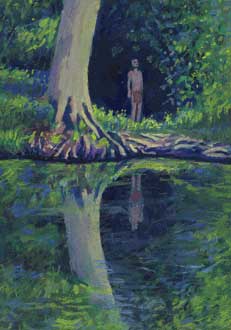
Young Man Learning to Sing from the Birds
Dissecting a birds sryrinx or cutting apart its complex lungs,
teaches us that species having an average of nine air sacs
---completely different than human and mammal lungs--
and this is important to know, as it is important to understand
the brain and heart of humans.
But just as anatomy is not entirely our destiny,
Ornithology is not just the mechanics of bird's song.
The whole meaning of human existence cannot
be separated form avian and no human existences.
For years I have been longing
for a science born of love and sympathy.
An ornithology of empathy already arises
here and there,
like the light of a candle
in the wide eyes of a curious child.,
or in the minds of birdwatchers everywhere
I don’t know much about birds
except what my eyes have seen
through loving attention.
Honest looking is hard work
and means leaving what one thinks one knows, behind.
One must look at birds with ones ears
and hear them with ones eyes.
I look for the humility of science in the love of birds.
There is no humility in a knowledge
whose motive is a biblical
"dominion over all that is on the earth".
Roman and Christian dominance,
recast as corporate concepts of intellectual property,
bent on world conquest,
bringing oppression to nature
under the reign of the intellect---
The Reign of the Intellect---
the masters of Mind and Finance
subsume many under the selfish power
or an imaginary "One" or a few---
Speciesism is the use and abuse by one species
of other species and turning all nature
into a Roman colony of conquered species---
each with a Latin Name.
The Linnaean system must not be about conquest
but about understanding and sympathy.
Humans are too truly ignorant of
what bird’s lives really are
to presume to be "Stewards".
It would be far better
to let the birds steward us.
Listening to birds is about learning
how to live better with every species on earth
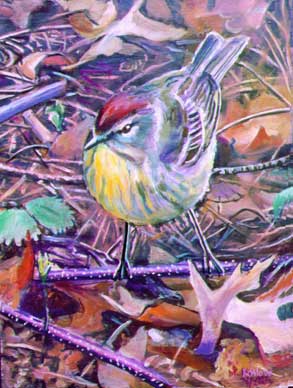
Palm Warbler
Flying Over Fences
The birds I have studied do not have
"territory"---
Measured units of space conquered
by a state or a military.
The birds of the "Louisiana Territory".
could have cared less that Napoleon
with all his delusions of grandeur
planted a ridiculous flag and
claimed this land as his own
and sold it to Jefferson,
who sent Lewis and Clark to
assess the spoils of the purchase.
The land bought "for a song"
has declined ever since
destroyed by cattlemen and mines and agribusiness
and the measure of the degradation
is precisely gauged by the holding of
bird song as cheap, free,
having little or no value
until at last, the human obsession with "territory"
has left places where "no birds sing", as Rachel Carson
protested in 1962.
The Carolina and Passenger Pigeon
are extinct and
many birds and their songs,
such as the Meadowlarks or the Bobolinks
diminished by the selfish claimants and
sellers of land that was not theirs to sell.
Ghost forests, ghost prairies,
ghosts of bird songs drifting over
desecrated landscapes
and nothing to show for the loss but a few rich people
living in MacMansions, Urban Sprawl and strip malls.
The birds do not "defend territory",
private property or claim ownership.
Yes, birds seek to protect their young
or the female on the nest,
who is vulnerable.
Yes, they sing about what is theirs.
But they do not have "territory"
they have life spaces, birthing places,
or rather, nesting spaces,
and only during certain times of year
and such spaces are quite fluid and often
shared by others of the same or different kinds.
They thus have intersecting, communal spaces
or family areas, in which they love each other
and raise their young.
I have seen Goldfinches nesting in a colony
of Blackbirds who were nesting next to Mallards
who were nesting below some Woodpeckers and Flickers
who themselves nested near Blue Grey Gnatcatchers and Orioles
and all of these were nesting in the midst
of a colony of Canada Geese, who themselves
nested near a Muskrat
who themselves shared an area with a doe and her fawns,
and a fox lived there too and a family of raccoons and many squirrels, frogs and
hundreds, thousands of other species of plants, fish
vertebrates and invertebrates.
Humans are the odd ones out.
While the map is not the territory
the territory is not the actual place
where birds and mammals
share their intimate lives.
Private Property is a human construction,
a surveyors map of measured lands conquered,
a legal trick that serves lawyers and banks
and lays waste to the lives of birds.
Who pays the birds back for the land stolen by the strip mall?
The idea of private property uses
and abuses the land of birds and animals
and its tyranny will end when the lives of animals
are understood and nature's rights are respected.
The law must be forced to recognize that land
in birds minds knows no fences.

Chickadee and High Bush Cranberries
Long Live the Fragile
I don’t know much about birds
Except what their selves have taught me.
I won’t pose as ignorant
but nor will I pretend to a certain knowledge
since I am often mistaken.
My life has been an effort to understand
all that is still not clear to me,
and it was full of reversals,
seeking and losing
certainties,
passions loved or regretted,
mistakes made, and ecstasies and
sufferings experienced or enjoyed.
What knowledge there is of value
was only gained through love.
What little I am able to learn
I want to see with my own eyes
and feel in my slow-to-learn heart.
I am skeptical of all who claim authority.
I refuse the "Dominion" over nature
supposedly given to me by an old book.
Better to let nature dominate me,
better to listen to its direct language and
doubt the two-tongued speech of humans.
Even my own questionable speech is uncertain.
What little I know of birds comes from loving them.
They know more than I about life.
Coming close to death did not fill me with visions of heaven
but with love for small beings with feathers
that spend their lives in flight and song.
I have tried to live with birds as closely
and with as much respect as those people who I love.
I woke up one morning and realized
that if there is something worth living for
it is in the Song Sparrows song
whose meaning is more
than can be said in words.
Bird sounds are the song of life,
as fragile as feathers and as fine as bird bones
honed and hefted for exquisite flights
as delicate as leaves of light
balanced and taking to the air
from the edge of a waterfall.
The meaning of bird sounds
is a message of fragility,
the unaccountable fragility of being—
a fragility threatened by humans.
Bird song is the precious and tentative
sound of hope---
hope for both birds and humans
hoping against more loss and extinction
the hope of all that are small,
wavering and fluttering, in uncertainty,
singing
on delicate wings.
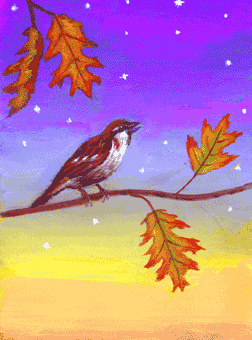
A Small One at Dawn
(House Sparrow)



Copyright © 2002-08 Mark Koslow.
All Rights Reserved.
